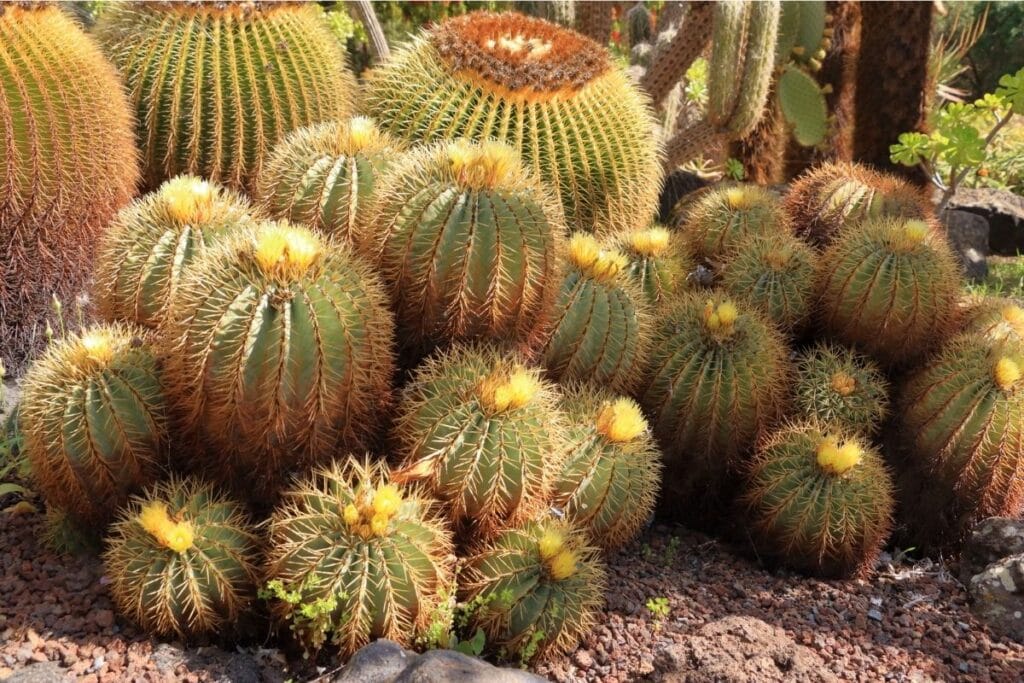Most plants are named after their appearance and the Ferocactus is a good example. This fierce-looking type of cactus can intimidate with its dense, rigid spines covering the entire rounded plant. But there’s more to this cactus than its name.
The Ferocactus is an impressive house and landscape plant and can be a practical and valuable resource in its xeric environment. Growing and caring is also rather straight-forward so keeping it as a house plant is definitely worth a shot.
What is a Ferocactus?
The Ferocactus is a genus of plants belonging to the cactus family. Like the Echinocactus, cacti under this group are commonly referred to as Barrel cactus because of the characteristically large stout stem that can be rounded to cylindrical in form. These round shape cacti are usually unbranching with ridges called ribs running down the stem but there are several species with smaller stems and form clumps.
In the wild, their height can range from 2 to 10 feet (3 meters) and the diameter from 18 to 33 inches (45 to 83 cm).
Young plants grown indoors are solitary and small enough to grow in containers. Ferocactus species have 20 to 28 ribs and their root system is shallow, reaching up to 8 inches (20 cm) deep.
The Barrel cactus is covered with hard large spines that protect it from thirsty creatures and small finer spines that help the plant deflect the desert sunlight. Their color ranges from white to gray and yellow to pink and their shape may be straight or hooked. They are even traditionally used as a fishing hook by the Native Americans (1).
Like most cacti, the Ferocactus bears amazing flowers. They appear at the apex of the plant in a striking ringed cluster. They are funnel-like in shape—the size of 1 to 2 inches in diameter when in full bloom.
The petals come in shades of red, orange, pink, and yellow, creating a soft visual accent against the green plant during the early summer in May. The resulting fruits look like small pineapples clustered on top of the plant. They are fleshy but dry and inside are thousands of tiny brown to black seeds (2).
Another nickname for the Ferocactus is “The Traveler’s Friend’ because in the desert, it serves as a moisture reservoir for a parched traveler in dire need of water. However, research says that the stored moisture from the plant is too alkaline to drink.
Barrels of cacti are a great addition to desert landscapes, succulent gardens, and rock gardens when they are grown in warmer climates. Barrels of cactus may be grown indoors as houseplants in colder climates.
Origin and Distribution
The Barrel cactus originated from the Sonoran Desert in North America. The group of plants is native and widely distributed in the southwestern United States and Mexico, occurring at elevations from 0 to 1,200 meters above sea level (2).
These desert plants thrive in flat sandy areas and porous rocky soils with limited water and bright sun.
Many species of Ferocactus are now commercially sold like f. fordii, f. latispinus, and f. wislizenii. They make unique house plants in pots and dish gardens and are attractive solitary cacti for themed desert landscapes and gardens.
How to Grow Barrel Cacti and Care tips
Light and Water
Barrel cacti require at least six hours of full sun per day to grow and thrive.
However, this low maintenance plant can tolerate up to 12 hours of direct sunlight per day, as long as they are not exposed to extreme heat or drought conditions.
Direct southern sunlight may burn the plant at the height of the summer, so you should move them back from the sunny window location or turn the slats on your blinds to diffuse the light.
Watering a cactus is almost unnecessary, considering the little to no moisture that they receive in their natural habitat. However, landscape and indoor barrel cactus can benefit from light watering, ideally rainwater. From spring to early fall, water thoroughly when the top ¼ inch (2 cm) of the soil is dry. Come late fall to winter, stop watering the plant and keep the soil dry (3).
Temperature and Humidity
Because they live in hot arid deserts, cacti are used to high temperatures and humidity, but they are fairly tolerant of changes. They can grow between 64 and 86 °F (10-30 °C). Some species like F. wislizeni are frost-sensitive and are prone to freeze-damage (4).
They appear as orange marks that fade to gray scars.
Pests and Diseases
Mealybugs and scale insects are the most common pests appearing on cacti. When kept unattended, they leave light to deep scars on the plant, and in severe cases, cause the plant to die.
They can be difficult to manually remove because of the spines and these pests latch in the grooves of the cactus. They can be removed using tweezers and brush or spray with isopropyl alcohol or apple cider vinegar diluted in water.
A barrel cactus, especially one grown at home, is susceptible to rotting. This is primarily due to wet soil and poor drainage (3).
To avoid this, follow the recommended watering regimen. Use a well-draining, porous potting medium and make sure that the pot or container has sufficient drainage holes.
Propagation and Maintenance
Ferocactus species are usually solitary, growing with a single stem that’s why they can only be propagated through seeds (2).
Flowering usually takes place when the plant is 2 to 3 years old, so seeds are not available until then and when planted, germination can take a week to 5 months, depending on external and internal factors.
Reproducing barrel cacti takes perseverance but the resulting plant and blooms are definitely rewarding.
There are few clustering species like F. robustus and F. glaucescens that produce clusters and these types can be suitably propagated using the rooted offsets. When dealing with cactus, make sure to wear the proper protective equipment to avoid injury to yourself and the plant.
Once in 2 or 3 years, it is recommended to repot a barrel cactus. This is to make sure that the soil remains airy and the roots able to breathe. Indoor cacti being irrigated with tap water are prone to mineral build up in the soil over time so repotting avoids the harm in this deposit.
Fertilizer application on a Ferocactus should be performed during the growing season. A balanced 10-10-10 fertilizer diluted to ¼ strength will boost the plant’s overall growth and keep it thriving (4).
Popular Species of Barrel Cactus
K. grusonii, Golden Barrel Cactus
Kroenleinia grusonii, also known as the golden barrel cactus, is a species of barrel cactus native to east-central Mexico. The stem is pale green and heavily ribbed with numerous areoles sprouting sharp radial spines. The plant can grow up to 3.3 feet (1 m) in height and diameter.
F. emoryi subsp. rectispinus, Long-spined Barrel Cactus
An apt name for this Ferocactus, it boasts long red spines all over a barrel-shaped stem reaching up to 10 inches (25 cm) in length. In summer, this great plant produces elegant large pale yellow flowers.
F. wislizenii, Compass Cactus
The Fishhook Barrel Cactus is stout and slow-growing and becomes columnar as it matures. Its defined ribs revolve about as the stem elongates and the plant is covered in reddish curved spines, hooked at the tip. The fishhook barrel cactus flowers vary in color from red to bright yellow to orange.
F. cylindraceus, California Barrel Cactus
The F. cylindraceus, or California Barrel Cactus, presents a visually striking appearance with its cylindrical shape with deeply grooved ribs and vibrant yellow to orange spines. Its architectural beauty is complemented by the emergence of colorful funnel-shaped flowers during the late spring to early summer months.
FAQs
What kills barrel cactus?
Overwatering cacti is a common cause of death for barrel cacti, as it can lead to root rot. Additionally, extreme temperatures, fungal infections, or physical damage can also harm barrel cactus.
How do I get my barrel cactus to bloom?
To encourage blooming in barrel cactus, ensure they receive plenty of sunlight and provide a well-draining soil mix. Additionally, stressors like slight underwatering or temperature fluctuations can sometimes trigger flowering.
Do barrel cactus grow fast?
No, Barrel cactus typically grow slowly, especially in comparison to other types of cacti. Growth rates can vary depending on environmental conditions such as temperature, sunlight, and soil quality.
How often should you water a barrel cactus?
Barrel cactus are drought tolerant plants that store water in their swollen stems. Water your cactus sparingly, allowing the soil to dry out completely between waterings. Watering every 2-4 weeks during the growing season should be sufficient.
What is the lifespan of a barrel cactus?
Barrel cacti are long-lived plants, with lifespans ranging from 50 to over 100 years or more under suitable growing conditions. Proper care and maintenance can help ensure the longevity of barrel cactus in cultivation.
Up next: How to Care for Golden Barrel Cactus (Echinocactus grusonii)
References
Reference List:
(1) Gauna, F. Barrel Cactus (Ferocactus sp., Britt & Rose). United States Department of Agriculture. 2020. (online) https://www.fs.fed.us/wildflowers/plant-of-the-week/ferocactus_sp.shtml.
(2) Ferocactus wislizeni. Arizona State University. 2020. (online) http://www.public.asu.edu/~camartin/plants/Plant%20html%20files/Ferocactuswisilzenii.html.
(3) Bailey, F. & Allaway, Z. Practical Cactus and Succulent Book. Penguin. 2019. P. 224.
(4) Matthews, R. Ferocactus wislizeni. 1994. Fire Effects Information System, USDA. (online) https://www.fs.fed.us/database/feis/plants/cactus/ferwis/all.html.
Close
*image by Dynamoland/depositphotos







